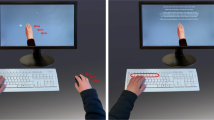Abstract
Some animated phenomena, such as reaction to stimuli or adaptation to changes, entail interactive dynamic presentation supported by a digital environment, where one can act upon certain digital objects or react to them ‘physically’ via touch-based or motion-sensitive interfaces. For example, users run their finger across a touchpad to move a pointer or to pan the camera across a space. A player of a flight-simulation game on a handheld device with built-in accelerometers can tilt the device to steer the virtual jet or hang glider, dodging obstacles along the way. The audience of the interactive installation Text Rain (Camille Utterback & Romy Achituv, 1999) may move their body parts like their hands or head to see their own projected image catching and lifting falling letters (please see Figure 8.2). In all the above instances, the audiences engage their bodies with the digital environments. In fact, they are not only engaged bodily, but also affectively. The connection between bodily engagement and affection can be explicated by arguments from phenomenology in philosophy. Through repeated engagement our bodies are able to build motor habits, to develop a sense of familiarity with a situation or an object (Russon, 2003, pp. 29–30). Habituation makes us feel at home in a ‘world’, whether it is physical or digital. It frees up our cognitive power to do more sophisticated activities involving self-expression or evaluation. We gain a sense of control and satisfaction this way. Hence, through motor action and habituation we are at ease in a digital environment, which feels familiar and intimate to us. This briefly explains our affective engagement with a particular digital design.
Access this chapter
Tax calculation will be finalised at checkout
Purchases are for personal use only
Preview
Unable to display preview. Download preview PDF.
Similar content being viewed by others
Author information
Authors and Affiliations
Copyright information
© 2013 Kenny K. N. Chow
About this chapter
Cite this chapter
Chow, K.K.N. (2013). The Body: We Act, We Feel. In: Animation, Embodiment, and Digital Media. Palgrave Macmillan, London. https://doi.org/10.1057/9781137283085_3
Download citation
DOI: https://doi.org/10.1057/9781137283085_3
Publisher Name: Palgrave Macmillan, London
Print ISBN: 978-1-349-44888-3
Online ISBN: 978-1-137-28308-5
eBook Packages: Palgrave Media & Culture CollectionLiterature, Cultural and Media Studies (R0)




